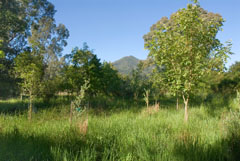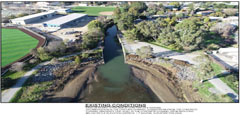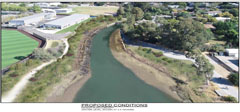College of Marin Ecology Study Area

Results of earlier restoration to the west of an area cleared in 2021, looking towards Mt. Tamalpais in 2018
This woodland site covers two acres adjacent to the multi-use path that links the college and Bon Air Avenue and is bounded by Corte Madera Creek and a tidal slough. We initiated the project in 1998 by pulling broom and installing a small number of coyote brush plants and oaks. It has developed into a cooperative effort with the College of Marin and has as its goal the eventual replacement of all eucalyptus and acacia trees on the site with a diverse woodland of native species.
In early 2005 a large area was cleared of non-native trees and replanted with nearly 400 native plants. A survey was conducted previously, and trees were retained to ensure that roosting herons and egrets would be disturbed as little as possible. The most successful native tree species planted are: coast live and valley oaks; box-elder; and black walnut. Oregon ash grows vigorously initially, but voles de-bark the base, killing the tree. The main understory plants are whiteroot sedge (Carex barbarae), introduced by Friends, and the pre-existing native creeping wild rye (Elymus triticoides). Both spread rapidly given the opportunity.
In the summer 0f 2021, the College of Marin cleared an illegal BMX track from a large portion of the ESA and in the process removed a number of acacia trees. With donations and the help of volunteers, Friends planted 85 shrubs and trees.
Whenever funds are available more eucalyptuses and acacias are removed, and Friends volunteers continue to remove periwinkle and non-native blackberry to expand the native plantings. A berm currently protects most of the area from tidal intrusion, however there is an opening in the southern corner, where several salt-marsh plant species are found. The rising sea level will jeopardize the riparian plants unless preventive action is taken.
Funding of the early planning phases was provided by the San Francisco Estuary Project. Funding for implementation has been provided by the Willis Evans Watershed Habitat Improvement Grant Program of the Marin Municipal Water District, and the California Alpine Club Foundation. Water for temporary drip systems is donated by the Ross Valley Sanitary District.
Lower College of Marin Corte Madera Creek Habitat Restoration
The State Coastal Conservancy has provided funding to develop 65% designs to remove part of the concrete channel at its downstream end. The Marin County Flood control District funded 100% designs and specifications. All the permits are in place and we are waiting for word on two grants that may fully fund construction.
The project illustrated below would create approximately 0.6 acres of new tidal and wetland habitats and 0.8 acres of new riparian and upland transitional habitats by removing or lowering approximately 625 lineal feet of concrete flood channel wall. Importantly, the new habitats would use appropriate native vegetation and be designed at elevations that would accommodate sea-level rise so they would be resilient to climate change.
Other notable project elements include:
1. Hydraulic analysis to confirm project would not increase flood water surface elevations
2. Improvements to an existing multi-use pathway and “pocket-park” adjacent to the creek
3. New vegetated basins and bio-swales for stormwater run-off to replace existing storm drains that feed directly into the creek
4. Re-use or recycling of all materials removed for the creation of the new habitats.



